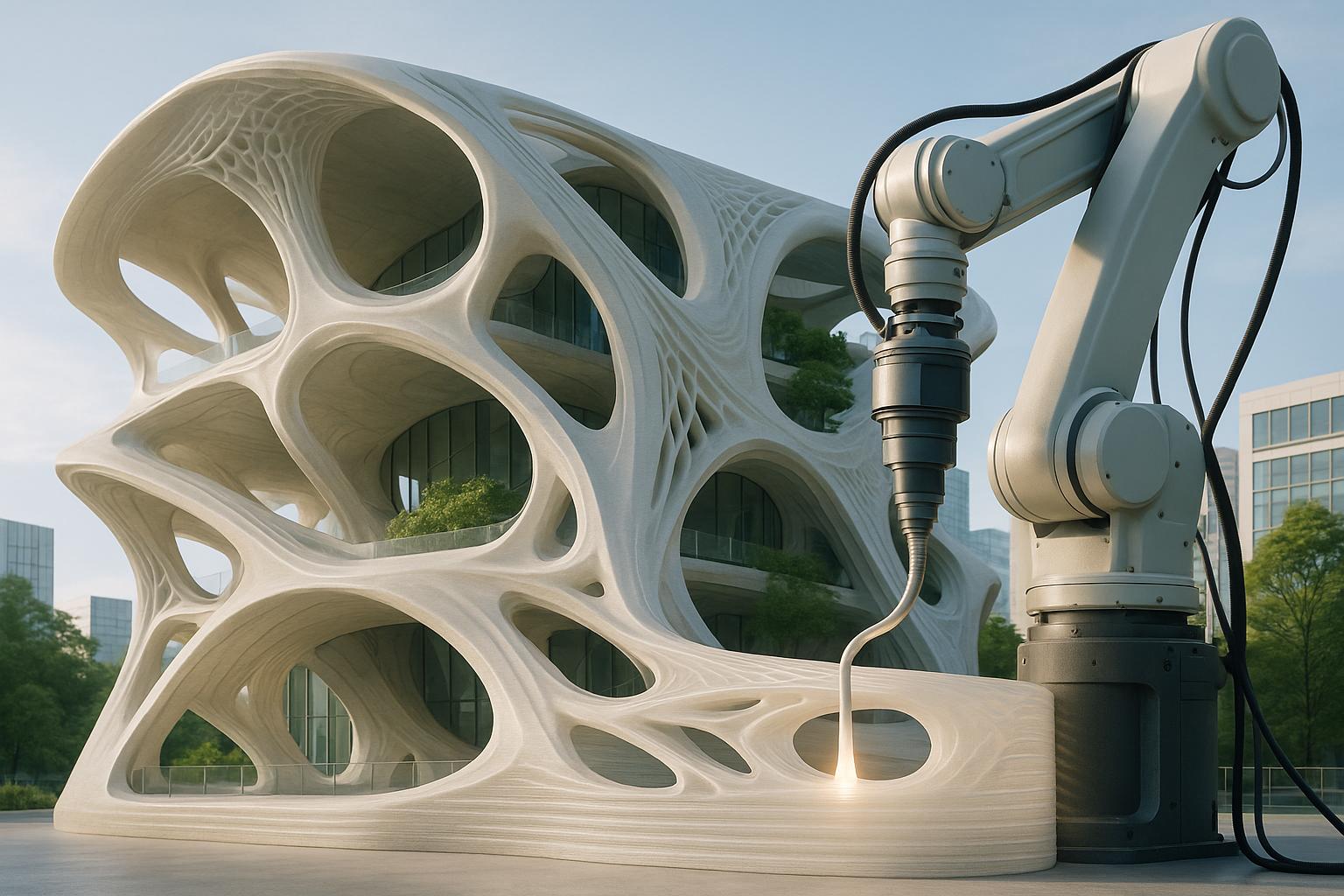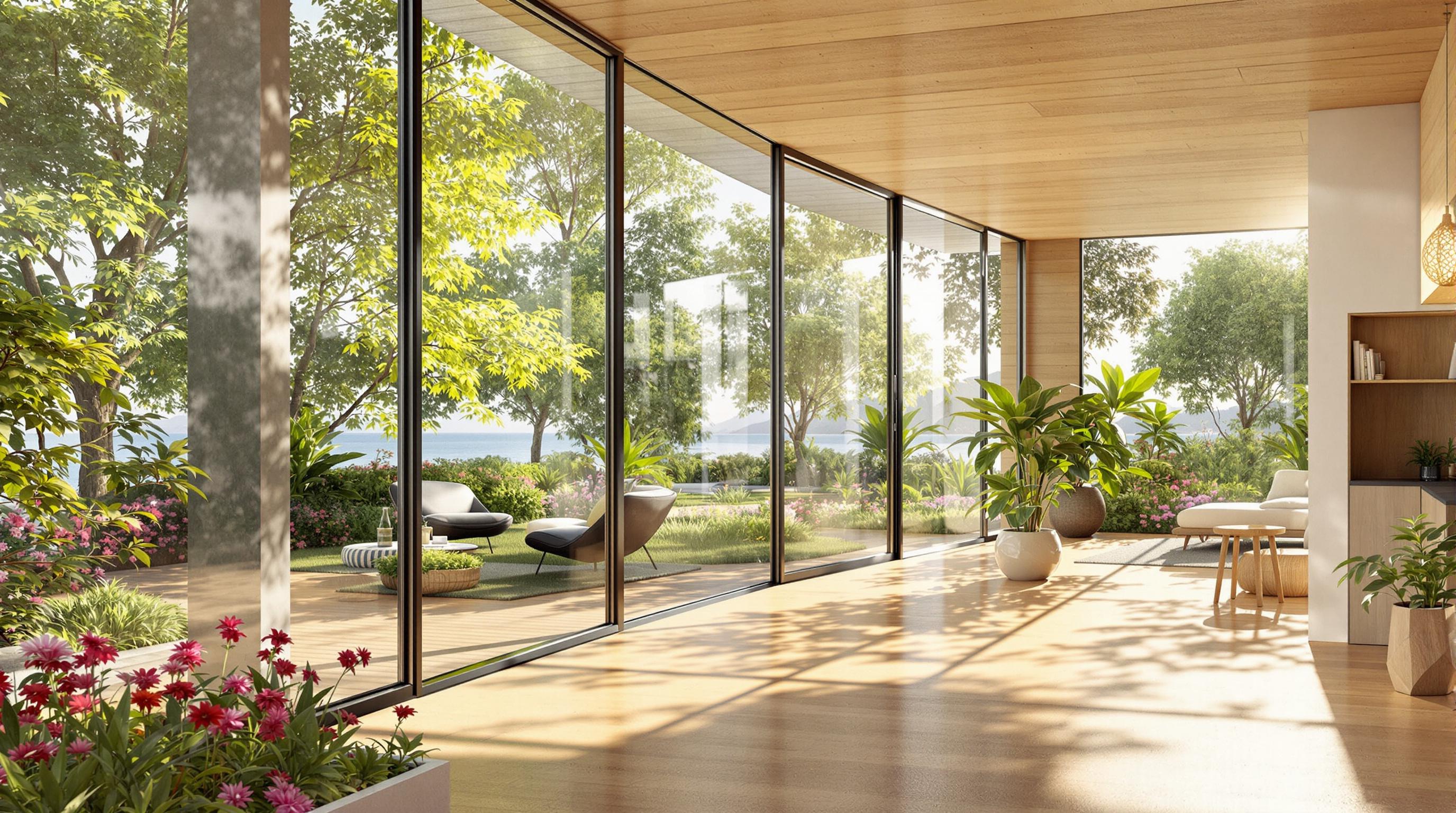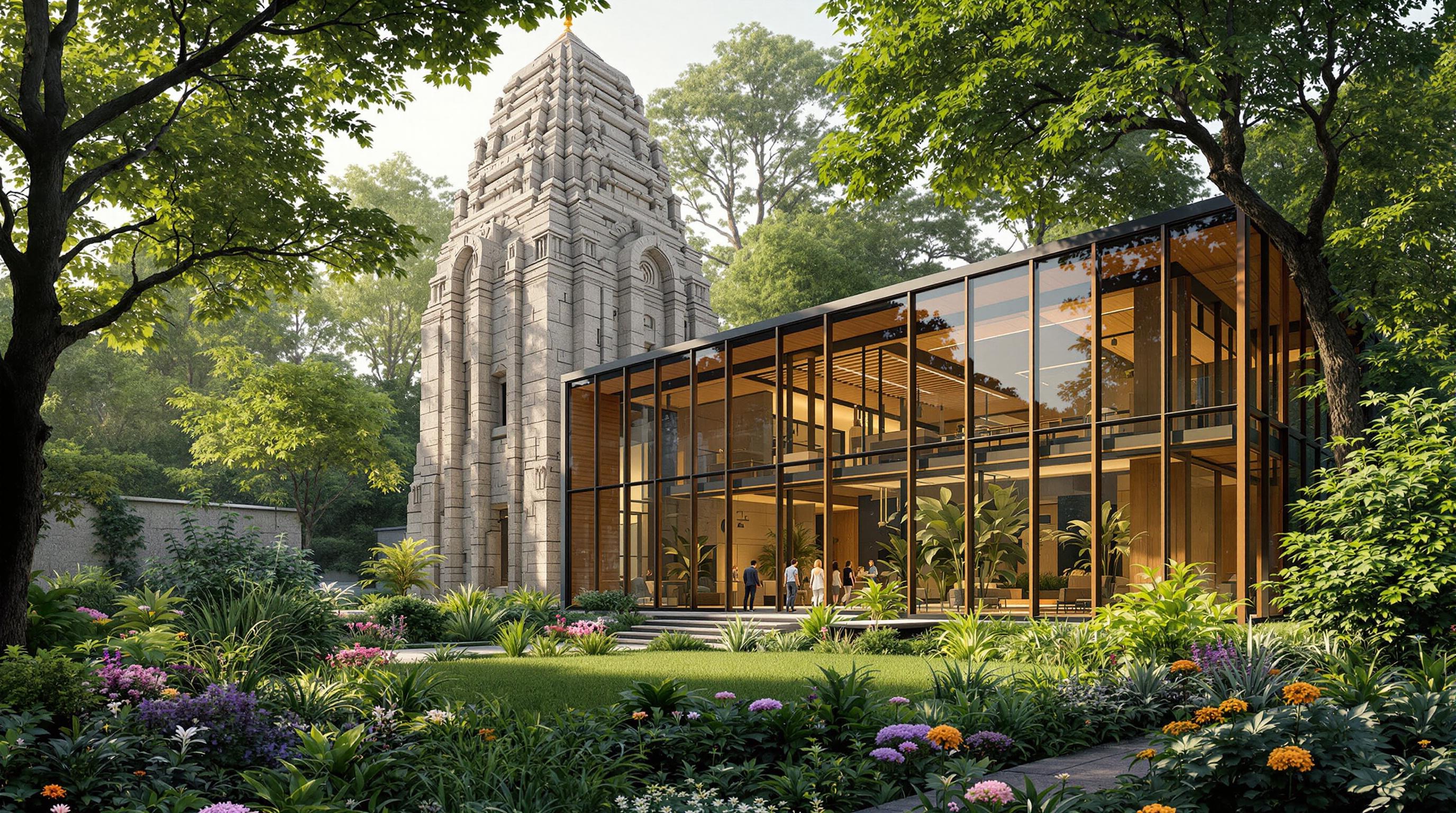Deconstructivist architecture breaks the rules of traditional design with bold, unconventional features. Here’s what defines it:
- Fragmented Forms: Shattered, broken shapes like Frank Gehry’s Guggenheim Museum Bilbao.
- Asymmetry: No balance, as seen in Daniel Libeskind’s Jewish Museum in Berlin.
- Warped Surfaces: Flowing, curved designs like Zaha Hadid’s Heydar Aliyev Center.
- Dynamic Interiors: Non-traditional layouts encouraging exploration, like the MAXXI Museum in Rome.
- Contrasting Elements: Mixing materials and styles, such as in the Royal Ontario Museum extension.
- Context Disruption: Boldly standing out from surroundings, like the Walt Disney Concert Hall.
These six traits challenge how we perceive and interact with buildings, creating spaces that are visually striking and thought-provoking.
What is Deconstructivism in Architecture?
1. Broken and Split Forms
Deconstructivist architecture takes traditional architectural forms and turns them on their head, shattering notions of unity and stability. By introducing fragmented shapes, distorted walls, and skewed lines, it creates what some call an "apparent chaos." These irregular forms redefine how we experience and understand space.
Take Frank Gehry's Guggenheim Museum Bilbao, for example. Completed in 1997 with a budget of $89 million, this iconic structure is wrapped in 33,000 ultra-thin titanium panels. The museum’s non-rectilinear volumes play with light and shadow, creating a dynamic visual experience. Gehry himself explained, "The randomness of the curves are designed to catch the light". Depending on where you stand, the building seems to shift and transform, making it a living embodiment of fragmented design.
Another striking example is Daniel Libeskind's Imperial War Museum North, completed in 2002. This building takes fragmentation to a symbolic level by deconstructing the shape of a globe and reassembling its shattered pieces. The result is a powerful commentary on conflict and reconstruction.
"I call it the largest deconstructed building in the world as it's one building, but broken down in many fragments." - Bernard Tschumi
Libeskind pushed the concept even further with the Crystal extension of the Royal Ontario Museum, unveiled in 2007. The design features five intersecting, metal-clad volumes that completely reject straight lines and right angles. This bold addition creates a dramatic interplay between the museum’s historic structure and its contemporary counterpart, sparking a fascinating architectural dialogue.
These broken forms aren’t just for show - they challenge how we perceive and interact with space. By embracing splits and fractures, these designs create dynamic environments that demand attention and engagement.
Interestingly, tools like Architecture Helper reveal the hidden logic behind these seemingly chaotic designs. Beneath the surface, these fragmented forms adhere to carefully calculated geometric principles, balancing artistic expression with structural soundness. They may look random, but there’s a deliberate method to the madness.
2. Non-Symmetrical Design
Non-symmetrical design is a hallmark of deconstructivist architecture, breaking away from the traditional notions of balance and harmony. Unlike classical architecture, which often relies on symmetry and mirrored elements along a central axis, deconstructivist structures embrace asymmetry to create striking, dynamic spaces. This approach is vividly showcased in some of the movement’s most iconic projects.
Take Daniel Libeskind's Jewish Museum in Berlin, completed in 2001, for example. Its bold, zigzagging structure and irregular, angular windows disrupt the facade with sharp, slicing lines that create a jarring rhythm. These asymmetrical elements amplify the museum's themes of displacement and fragmentation, making the building itself a part of the narrative.
"When I explored the site for the Jewish Museum in Berlin, I put myself into the souls of those who are not there, into the emptiness I felt." – Daniel Libeskind
This rejection of symmetry shifts the architectural focus to horizontal and diagonal lines, encouraging active exploration. Instead of offering a single, static viewpoint, these designs invite viewers to engage with the structure from multiple angles, each revealing a new layer of meaning.
Bernard Tschumi, a key figure in deconstructivist architecture, highlights this deliberate departure from traditional design norms:
"Architecture must express a sense of rupture and contradiction."
Despite their seemingly chaotic appearance, these buildings are far from random. Tools like Architecture Helper demonstrate how asymmetrical designs can maintain structural stability while challenging visual expectations. This balance between artistic vision and engineering precision is a defining feature of deconstructivist architecture.
Architectural theorist Mark Wigley captures the essence of this approach:
"A deconstructive architect is therefore not one who dismantles buildings, but one who locates the inherent dilemmas within buildings."
3. Warped Surface Treatments
Warped surfaces push the boundaries of traditional architectural design, becoming a defining feature of deconstructivism. These fluid, distorted forms break away from static structures, creating a bold visual language that challenges conventional norms. This approach is vividly demonstrated in several iconic projects.
One standout example is the Heydar Aliyev Center in Baku, Azerbaijan, designed by Zaha Hadid Architects and completed in 2007. The building’s flowing exterior, constructed with GFRC panels and supported by a hidden steel space frame and curtain walls, creates seamless, gravity-defying curves.
Zaha Hadid described the vision behind the design:
"We wanted to bring emotion into the context and to enhance it, suggesting an ongoing relationship between the inside and the outside of the building, public and private, architecture and landscape, so visitors would feel metaphorically welcomed with an embrace." – Zaha Hadid
Project architect Saffet Kaya Bekiroglu elaborated on the philosophy driving this approach:
"Our intention was to relate to that historical understanding of architecture, not through the use of mimicry or a limiting adherence to the iconography of the past, but rather by developing a firmly contemporary interpretation, reflecting a more nuanced understanding."
These warped surfaces do more than just captivate the eye - they blur the boundaries between interior and exterior spaces while pushing the limits of engineering. By embracing such complex geometries, architects challenge traditional structural methods, a concept echoed by architectural theorist Mark Wigley. Balancing these intricate designs with structural stability, firms like Architecture Helper help translate these ambitious visions into reality.
sbb-itb-1be9014
4. Fluid Indoor Spaces
Deconstructivist architecture transforms indoor environments by moving away from traditional layouts, creating spaces that encourage movement and interaction in unexpected ways. This fresh perspective reshapes how people experience and engage with interior spaces.
Take the MAXXI National Museum of 21st Century Arts in Rome, designed by Zaha Hadid and completed in 2010, as an example. The museum's interior is a maze of overlapping, curving spaces that challenge conventional architectural norms. As visitors move through the space, they encounter continuously shifting forms and perspectives, offering a dynamic experience.
Another striking example is the UFA Cinema Center in Dresden, Germany, completed in 1998. Designed by Coop Himmelb(l)au, the building features a transparent, polygonal glass foyer. Inside, exposed staircases and bridges create an urban-like pathway, inviting visitors to explore the space in a way that's far from traditional.
Architectural theorist Janette Baumann captures the essence of these designs, stating:
"Deconstructivist architects sought to fragment a construction and explore asymmetrical relations - while still maintaining the core function of a space."
The Groninger Museum in the Netherlands offers yet another example of this approach. Its interior blends Bauhaus influences with Italian terrazzo, creating a design that deliberately disrupts spatial expectations. This bold fusion redefines how the building functions and how visitors interact with it.
These fluid, ever-changing interiors engage users on a deeper level, encouraging exploration and discovery. By breaking away from rigid, hierarchical layouts, deconstructivist architecture turns buildings into dynamic, experiential environments that continue to shape modern architectural thought.
5. Clashing Building Elements
Deconstructivist architecture thrives on blending contrasting elements to create visual tension, pushing the boundaries of traditional architectural harmony. This bold approach can be seen in several iconic structures.
Take the Guggenheim Museum Bilbao, for example. Its design merges titanium, glass, and limestone into a striking composition. The exterior features flowing, curved titanium panels that reflect light beautifully, intersected by angular glass sections that break up the smoothness of the forms.
Other examples include Dresden's Museum of Military History and the UFA Cinema Center, where modern elements disrupt historical facades. In Dresden, a sharp steel and glass shard pierces through the building, creating a stark contrast. Similarly, the UFA Cinema Center juxtaposes an angular concrete block against a sleek, glass foyer, redefining the visual narrative.
"A deconstructive architect is therefore not one who dismantles buildings, but one who locates the inherent dilemmas within buildings."
- Mark Wigley
Zaha Hadid's Guangzhou Opera House also exemplifies this principle. It combines materials like glass, concrete, granite, and steel in a design that balances fluid, curving forms with sharp, angular features. This deliberate tension disrupts visual harmony, staying true to deconstructivist ideals.
6. Breaking Local Context
Deconstructivist architecture thrives on challenging traditional norms by creating deliberate contrasts with its surroundings. By playing with fragmented forms and unexpected designs, these structures disrupt the usual harmony of their environments, offering a fresh critique of conventional design principles.
Take the Walt Disney Concert Hall in Los Angeles, for example. Completed in 2003, Frank Gehry’s design uses stainless-steel surfaces that catch and reflect light in fascinating ways. This creates a striking contrast with the rigid, traditional grid of downtown Los Angeles’s skyscrapers.
The Heydar Aliyev Centre serves as another example, breaking away from the rigid architectural patterns of its local context. Meanwhile, the Royal Ontario Museum extension in Toronto, designed by Daniel Libeskind, takes this concept further. His "Michael Lee-Chin Crystal" boldly integrates five intersecting, metal-clad structures that seem to slice through the museum’s historic facade.
These projects don’t just stand out visually - they deliberately challenge the historical and architectural norms of their locations.
"The projects in this exhibition mark a different sensibility, one in which the dream of pure form has been disturbed." - Phillip Johnson and Mark Wigley
The Groninger Museum is another example, using a mix of materials to disrupt the urban landscape around it. Similarly, Frank Gehry’s 1978 renovation of a Santa Monica residence reimagines the suburban home by reshaping its spatial boundaries. This project, like many others in the deconstructivist movement, redefines how we think about residential spaces and their relationship to their surroundings.
Through these bold designs, deconstructivist architects engage with their environments in ways that are intentionally contradictory and disruptive, forcing us to rethink what architecture can - and should - be.
Conclusion
Deconstructivist architecture shakes up the way we think about buildings by stepping away from traditional norms. Its six defining traits - fractured forms, asymmetry, warped surfaces, fluid spaces, clashing elements, and disruption of context - create structures that are both visually bold and conceptually thought-provoking.
This approach sparks a constant conversation:
"In Deconstructivism, architecture becomes an active dialogue, an unfolding story rather than a fixed statement."
These designs embrace imperfection and instability, fueling that ongoing conversation.
Tools like Architecture Helper make it easier for enthusiasts to dive into the complexities of deconstructivist design, offering a deeper appreciation for its layered approach.
"A deconstructive architect is therefore not one who dismantles buildings, but one who locates the inherent dilemmas within buildings."
FAQs
How does deconstructivist architecture achieve both artistic freedom and structural stability despite its unconventional design?
Deconstructivist architecture strikes a fascinating balance between artistic expression and structural soundness. By embracing fragmented shapes and unconventional forms, it challenges symmetry and the traditional notion of design, all while relying on cutting-edge engineering to ensure stability and functionality. Despite their seemingly chaotic appearance, these structures are meticulously planned to stand strong and serve their purpose.
Visionaries such as Frank Gehry and Zaha Hadid have mastered the art of turning bold, imaginative concepts into reality. Using advanced materials and groundbreaking construction techniques, they push the boundaries of what architecture can be. Their work proves that daring creativity and reliable structural design can go hand in hand, redefining the limits of modern architecture.
How do deconstructivist buildings interact with their surroundings and challenge traditional architecture?
Deconstructivist buildings stand out by defying traditional architectural norms, offering a fresh take on how structures interact with their surroundings. With fragmented forms, irregular angles, and non-linear designs, they introduce a sense of disruption that contrasts with the symmetry and order of conventional buildings. This daring style pushes viewers to reconsider what space, structure, and harmony mean in architecture.
Take the Guggenheim Museum Bilbao by Frank Gehry, for instance. Its flowing, unexpected shapes seem to challenge the stability of its environment while evoking a sense of movement and fluidity. These designs don’t just stand apart - they invite us to see architecture as a reflection of the complexities and energy of modern life.
What challenges do architects face when designing curved surfaces and dynamic spaces in deconstructivist architecture?
Designing curved surfaces and dynamic spaces in deconstructivist architecture comes with its own set of challenges. One of the primary concerns is structural stability. These unconventional forms often push the limits of traditional construction, requiring creative engineering solutions and advanced materials to ensure both safety and longevity. Standard building methods frequently fall short, adding another layer of complexity to the process.
Another major obstacle is accurate modeling and visualization. Architects depend on sophisticated software to bring these intricate designs to life. This not only requires a high level of technical skill but also access to specialized tools capable of handling such complexity. As a result, deconstructivist architecture becomes a careful balance of bold artistic expression and precise technical execution.


